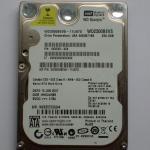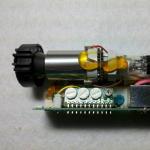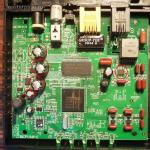In times when cell phones There were thick and black and white, processors - single-core, and Gigahertz seemed an insurmountable plank (20 years ago), single characteristic To compare the capacity of the CPU clock frequency. The decade after the second important characteristic was the number of nuclei. Nowadays, a smartphone, a thickness of less centimeter, contains nuclei more, and the clock frequency has higher than a simple PC of those years. Let's try to figure out what the processor's clock frequency affects.
The frequency of the processor affects the speed with which the processor transistors (and there are hundreds of millions inside chip) produce switching. It is measured in the number of switches per second and is expressed in millions or billions of Hertz (Meghertz or Gigahertz). One hertz is one switching processor transistors per second, therefore, one gigahertz is one billion such switches for the same time. For one switch, if we say simplistic, the kernel makes one mathematical operation.
Following ordinary logic, you can come to the conclusion that the more frequency - the faster the transistors in the kernels are switched, the more the tasks are solved. That is why in the past, when the bulk of processors was essentially improved by Intel X86, architectural differences were minimal, and it was clear that the greater the frequency of the clocks - the faster the calculations go. But over time everything has changed.
Is it possible to compare the frequencies of different processors
In the 21st century, the developers taught their processors to handle for the beat not one instruction, and more. Therefore, processors with the same frequency of clocks, but based on different architectures, give a different level of speed. Intel Core i5 2 GHz and Qualcomm Snapdragon. 625 2 GHz are different things. Although the second nuclei is greater, but in difficult tasks it will be weaker. Therefore, the frequency of different types of cores can not be compared, it is important to take into account the specific performance (the number of instructions for the tact).
If you pose an analogy with machines, then the clock frequency is the speed in km / h, and the specific performance is a loading capacity to kg. If the passenger car (ARM processor for a smartphone) and dump truck (chip x86 for PC) - then, with an equal speed, the car will take a couple of hundred kilo at a time, and a truck is a few tons. If we talk about different types Nores for smartphones (Cortex A53, Cortex A72, Qualcomm Kryo) - then these are all cars, but with different capacity. Accordingly, then the difference will already be so huge, but also significant.

You can compare only the clock frequencies of the nuclei on the same architecture. For example, MediaTek MT6750 and Qualcomm Sanapdragon 625 contains 8 cortex A53 cores. But the MTC has their frequency - up to 1.5 GHz, and in Kualomm - 2 GHz. Consequently, the second processor will work for about 33% faster. But Qualcomm Snapdragon 652, although there is a frequency of up to 1.8 GHz, but works faster than model 625, as it uses more powerful Cortex A72 kernels.
What gives the high frequency of the processor in the smartphone
As we have already found out, the higher the clock frequency - the faster the processor works. Consequently, the performance of a smartphone with a higher frequency chipset will be higher. If one smartphone processor contains 4 KRYO kernels by 2 GHz, and the second is the same Kryo kernels by 3 GHz, then the second will be about 1.5 times faster. This will speed up the launch of applications, will reduce the inclusion time, will allow you to quickly process heavy sites in the browser, etc.
However, choosing a smartphone with high frequencies of the processor, one should also remember that what they are higher - the greater the energy consumption. Therefore, if the manufacturer wound a bigger Gigahertz, but did not optimize the device properly - it may overheat and enter the "trottling" (forced frequency reset). Such a disadvantage in one time suffered, for example, Qualcomm Snapdragon 810.

Probably, each user has little familiar with the computer came across a bunch of incomprehensible characteristics when choosing a central processor: TechProcess, cache, socket; Approached advice to friends and acquaintances competent in the question computer Iron.. Let's figure out in the manifold of all kinds of parameters, because the processor is the most important part of your PC, and understanding its characteristics will give you confidence when buying and further use.
CPU
CPU personal computer It is a microcircuit that is responsible for performing any data transactions and controls peripheral devices. It is contained in a special silicon building, called a crystal. For a brief designation use abbreviation - CPU (central processor) or CPU. (from English Central Processing Unit is a central processing device). In the modern market of computer components there are two competing corporations, Intel and AMD.who are constantly involved in the performance of new processors, constantly improving the technological process.
TechProcess
TechProcess - This is the size used in the production of processors. It defines the magnitude of the transistor, the unit of measurement of which is nm (nanometer). Transistors, in turn, make up the internal basis of the CPU. The essence is that the continuous improvement of the manufacturing technique allows to reduce the size of these components. As a result, there are much more on the crystal of the processor. This contributes to the improvement of the CPU characteristics, so its parameters always indicate the used technical process. For example, Intel Core i5-760 is made on the process of 45 nm, and the Intel Core i5-2500K is 32 nm, based on this information, it can be judged how modern is modern and exceeds the performance of its predecessor, but when choosing it is necessary to take into account other parameters.
Architecture
Also, the processors are typical of such a characteristic as architecture - a set of properties inherent in a whole processor family, as a rule, produced for many years. In other words, architecture is their organization or internal design of the CPU.
Number of Cores
Core - most main element central processor. It is a part of the processor capable of performing one command stream. The kernels differ in the size of the memory cache, the tire frequency, manufacturing technology, etc. Manufacturers with each subsequent technical process are assigned to them new names (for example, the kernel aMD processor - Zambezi, and Intel - Lynnfield). With the development of processor production technologies, there was an opportunity to be placed in one case more than one nucleus, which significantly increases the performance of the CPU and helps to perform several tasks at the same time, as well as using several nuclei in the operation of programs. Multi-core processors will be able to quickly cope with archiving, video decoding, work of modern video games, etc. For example, ruler core processors 2 Duo and Core 2 Quad from Intel, which use dual-core and quad-core CPUs, respectively. At the moment, processors C 2, 3, 4 and 6 cores are massively available. Them large quantity Used B. server solutions And it is not required to the ordinary PC user.
Frequency
In addition to the number of cores for performance affects clock frequency. The value of this characteristic reflects the performance of the CPU in the number of clocks (operations) per second. Another important characteristic is tire frequency (FSB - Front Side Bus) Demonstrating the speed with which data is met between the processor and the periphery of the computer. The clock frequency is proportional to the tire frequency.
Socket
To the future processor under the upgrade was compatible with the available motherboard, It is necessary to know its socket. Called socket connectorin which the CPU is installed on motherboard Computer. The type of socket is characterized by the number of legs and the manufacturer of the processor. Various sockets correspond to specific CPU types, thus, each connector allows the installation of a specific type of processor. Intel uses Socket LGA1156, LGA1366 and LGA1155, and AMD - AM2 + and AM3.
Cache
Cache - The amount of memory with a very high access speed required to accelerate access to data constantly in memory with a lower access speed (RAM). When choosing a processor, remember that an increase in the size of the cache memory has a positive effect on the performance of most applications. Cache of the central processor differs in three levels ( L1, L2 and L3), locating directly on the core of the processor. It includes data from RAM for more high speed Processing. It is also necessary to consider that for multi-core CPUs, the amount of the first level cache for one nucleus is indicated. The second-level cache performs similar functions, featuring lower speed and large volume. If you intend to use the processor for resource-intensive tasks, the model with a large amount of second-level cache will be preferable, given that the total volume of the L2 cache is indicated for multi-core processors. Cache L3 Complete the most productive processors, such as AMD Phenom, AMD Phenom II, Intel Core i3, Intel Core i5, Intel Core i7, Intel Xeon. The third-level cache is the least high-speed, but it can reach 30 MB.
Energy consumption
The power consumption of the processor is closely related to the technology of its production. With a decrease in the lane venet meters, an increase in the number of transistors and an increase in the processor clock processors, the CPU electricity consumption is increased. For example, the Core i7 ruler processors from Intel require up to 130 or more watts. The voltage fed to the kernel brightly characterizes the power consumption of the processor. This parameter is especially important when choosing a CPU to use as a multimedia center. IN modern models Processors are used by various technologies that help to deal with excessive power consumption: embedded temperature sensors, automatic voltage control systems and processor core frequency systems, energy-saving modes at a weak load on the CPU.
Additional features
Modern processors have acquired opportunities for working in 2 and 3 channel modes with rAM, which significantly affects its performance, and also support a larger set of instructions, lifting their functionality on new level. Graphic processors handle video on their own, thereby unloading CPU, thanks to technology DXVA. (From English DirectX Video Acceleration - Acceleration of the video component DirectX). Intel uses the aforementioned technology Turbo Boost. To dynamically change the clock frequency of the central processor. Technology Speed \u200b\u200bStep. manages the power consumption of CPU depending on the activity of the processor, and Intel Virtualization Technology. hardware creates a virtual environment for using multiple operating systems. Also modern processors can be divided into virtual kernels using technology Hyper Threading.. For example, a dual-core processor is able to divide the clock frequency of one nucleus for two, which contributes high performance data processing using four virtual nuclei.
Reflecting on the configuration of your future PC, do not forget about the video card and her GPU. (from the English. Graphics Processing Unit is a graphical processing device) - the processor of your video card, which is responsible for rendering (arithmetic operations with geometric, physical objects, etc.). The greater the frequency of its kernel and the memory frequency, the smaller the load on the central processor. Special attention to K. graphic processor must show gamers.
Each user of computer equipment was rarely asked by this question, especially deciding to purchase new equipment. But in order to answer the question - the processor's clock frequency on what does it affect, it is necessary first to understand what it represents?
Influence of the clock frequency of the processor for performance?
This figure indicates the number of computing processor produced in one second. And naturally, that the higher the frequency, the more operations per unit of time can produce a processor. In modern devices, this indicator is ranging from 1 to 4 GHz. It is determined by multiplying the base or external frequency to a certain coefficient. Increase processor frequency by "acceleration". World leaders in the production of these devices some of their products orient on their possible overclocking.
When choosing such a device, an important performance indicator is not only its frequency. It also affects the romance of the processor.
Currently, there are practically no devices that have only one core. Multi-core processors completely outstretted their single-line predecessors from the market.
About nuclear and clock frequency
Let's start with the fact that the statement that the processor has a frequency equal to the general Suma of this indicator of each nuclei is not true. But why is a multi-core processor better and more efficient? Because each of the cores produces its part common workIf this allows the processor processing program. Thus, loanness significantly increases the system performance, if the processed information can be divided into parts. But if it is impossible to do this, only one core of the processor works. At the same time, its overall performance is equal to the clock frequency of this nucleus.
In general, if you have to work with graphics, static image, video, music multi-core processor is just what is needed. But if you are a playground, then in this case it is better to take a very multi-core processor, because programmers may not provide for the separation of software processes into parts. Therefore, a more powerful processor for games suitable better.
About processor architecture
In addition, the performance of the system depends on the processor architecture. Naturally, the shorter the signal path from the point of sending to the destination, the faster the information is made. For this reason, processors from intel companies They work better than from AMD, with the same clock frequency.
RESULTS
Thus, the clock frequency of the processor is its strength or power. It affects system performance. But at the same time it is necessary not to forget that this parameter, except for the power, depends on the number of cores and from the architecture of this device. It is necessary to choose a processor, given how to work with the future? For games, it is better to take a processor more powerful processor, for all the rest, a multi-core processor is suitable with a very large clock frequency.
Frequency? GHz? 2.6? GHz?
From the point of view of technical, the definition sounds:
The clock frequency is the number of clocks produced for a certain amount of time.
For me, it was also a dark forest, when in the first year I wrote it in a notebook, leaning on a programmer. Then I, like many now I did not understand what it means and what is it necessary for?
I will explain on the examples, it will be easier to figure it out with it, as it works. Let's start.
Explanation for example
Let's imagine that 1 blow to the musical drum is 1 tact in the processor. We take two drums for comparison, one by one is hit 120 times a minute, the second is hit 80 times per minute, it will be obvious that the frequency of the sound of the first drum is higher and louder than the second.
For an independent experiment, you can take an ordinary writing handle in your hand, damage 10 seconds and make 10 shots with an edge from the handle on the table, and then for the same time to make 20 shots, the result will be the same as with the drums.  It is also necessary to understand that if the musician has four drums, instead of one, the number of shocks will not multiply on the number of drums, but it is distributed to everything, thereby will appear more opportunities in playing sounds.
It is also necessary to understand that if the musician has four drums, instead of one, the number of shocks will not multiply on the number of drums, but it is distributed to everything, thereby will appear more opportunities in playing sounds.
Remember! The number of nuclei is not multiplied by Gighellians.
And that is why nowhere in descriptions there are no such large numbers as 12GHz or 24GHz, well, etc., if only in the results of overclocking, and it is unlikely.  In the microprocessor for the clock, some number of teams are performed. That is, the higher the clock frequency, the more commands performed for a certain amount of time occurs inside the microprocessor.
In the microprocessor for the clock, some number of teams are performed. That is, the higher the clock frequency, the more commands performed for a certain amount of time occurs inside the microprocessor.
By the way, about what is inside, you can find out in the article - "", which has already appeared on the blog. Further interesting, so to always be aware of the appearance of new articles.
What is measured and as indicated
In Gigahertz or in Meghertz, in abbreviated form is indicated as - GHz or MHz, GHz or MHz.
3.2 GHz \u003d 3200 MHz is the same, only in different values.
On sites, in the description, the frequency is designated in different ways. Examples are shown below and highlighted in blue. 
Impact in work and games
In a computer, this parameter affects:
- system performance
- responsiveness and speed
- computing power
- performing multiple tasks in the same time
- and much dr.
How does it affect games? Directly depends on how much power is needed for the game. Manufacturers recommend using from 3.0 GHH and higher. It all depends on the game itself and recommendations that are attached to it. Where to watch them? You can read in which I told everything in detail.
One of the CPU models, which has the greatest clock frequency at the time of writing the article is Intel i7-8700K. 
Many of course believe that this parameter is not the most important, but this indicator directly affects the performance of the PC, so if you have the opportunity to purchase higher gigaretz, I advise him to consider it.
In my opinion, I would consider these optimal models for various tasks:
- Intel Pentium G5600.
- AMD Ryzen 3 2200G
- Intel Core i3 8100
- Intel Core i5 8400
- Intel Core i7 8700
For what tasks are they intended? You can see in the article as not to regret it.
Prices do not specify, as they always change, so look. The choice is yours.
I hope you have become everything. I will finish this. To stay up to date on the appearance of new, understandable and interesting articles on my blog, leave comments, I am always interested in your opinion. Thanks for attention. See you in new articles.




